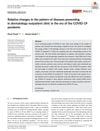Pattern Changes of Cutaneous Dermatoses Among Iraqi Women Preceding and During the COVID-19 Pandemic
May 2022
in “
F1000Research
”

TLDR During the COVID-19 pandemic, Iraqi women experienced more hair loss and certain skin conditions, while contagious skin infections decreased.
The study "Pattern changes of cutaneous dermatoses among Iraqi women preceding and during the COVID-19 pandemic" analyzed skin disease patterns in 2657 Iraqi women before and during the pandemic. It found a significant increase in hair loss, specifically telogen effluvium, and a decrease in cutaneous contagious viral infections during the pandemic. Other infections, including bacterial and parasitic, also decreased, while dermatophytosis increased but not significantly. Acne vulgaris, rosacea, lichen planus, urticaria, pityriasis rosea, seborrheic dermatitis, and vitiligo increased, but psoriasis, alopecia areata, other types of dermatitis, and melasma decreased, though not significantly. The changes could be due to COVID-19 infection, pandemic-related stress, curfew, or mask-wearing. The study also noted an increase in acne flares and rosacea due to long-term mask wearing, and an increase in irritant contact dermatitis due to overuse of antiseptic agents and frequent hand and face washing. The study was limited by being a single center study and data was only measured over a short period.


